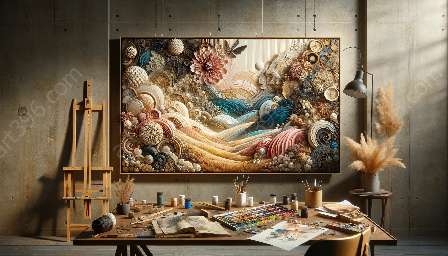Mixed media art has become an integral part of modern society, encompassing a wide range of artistic expressions that combine different mediums to create unique pieces. As the popularity of mixed media art continues to grow, it is important to consider its economic implications, both from the perspective of creators and consumers. This article will delve into the financial impact, market trends, and opportunities associated with mixed media art, shedding light on its role in the contemporary art world.
The Role of Mixed Media Art in Modern Society
Mixed media art offers a platform for artists to break free from the constraints of traditional art forms and experiment with various materials and techniques. It encourages creativity, self-expression, and innovation, thus contributing to the cultural richness of modern society. Through its diverse and eclectic nature, mixed media art reflects the complexity of the contemporary world and serves as a means of engaging and challenging the audience's perceptions.
Economic Implications
1. Market Trends
The market for mixed media art has experienced significant growth in recent years, driven by an increasing demand for unique and personalized artworks. This trend is fueled by the desire of art enthusiasts to own pieces that defy categorization and offer a multi-dimensional visual experience. As a result, artists specializing in mixed media have found new opportunities to showcase their work and reach a wider audience.
2. Financial Impact on Creators
For artists, creating mixed media art can have both positive and negative economic implications. On the positive side, the diversity of materials and techniques allows artists to explore new avenues for artistic expression and potentially increase the value of their work. The ability to combine various media also opens doors to diverse revenue streams, such as collaborations with brands, licensing deals, and commissioned projects.
On the other hand, the cost of acquiring and maintaining a diverse range of materials and tools can be financially challenging for artists, especially those who are just starting their careers. Finding a balance between artistic experimentation and financial sustainability is a key consideration for mixed media artists.
3. Consumption and Investment
From a consumer perspective, the allure of mixed media art lies in its ability to evoke emotions and spark curiosity. As more collectors and art enthusiasts recognize the value of mixed media pieces, the market for such artworks continues to expand. Consumers often view mixed media art as a sound investment due to its potential for appreciation and the unique narrative it carries.
Furthermore, the growing interest in sustainable and eco-friendly art practices has led to an increased demand for mixed media artworks created from recycled or repurposed materials. This trend aligns with the values of socially and environmentally conscious consumers, creating opportunities for artists who prioritize sustainable practices.
Opportunities and Challenges
Despite the promising trends in the market, mixed media artists face challenges such as establishing recognition and establishing consistent pricing strategies. The varied nature of mixed media art can make it difficult for artists to position themselves within the art market and gain the visibility they deserve. Moreover, the lack of standardized valuation methods for mixed media art poses challenges for both artists and collectors, impacting the overall economic landscape.
On the other hand, the evolving digital landscape has opened new avenues for mixed media artists to market and sell their work globally. Online platforms and social media have become powerful tools for artists to connect with a wider audience and diversify their revenue streams. This digital shift presents an opportunity for artists to explore direct-to-consumer sales and engage with art lovers on a more personal level.
In Conclusion
Mixed media art has emerged as a dynamic and economically significant aspect of the contemporary art world. Its influence extends beyond artistic expression, playing a pivotal role in shaping market trends and consumer behavior. By understanding the economic implications of creating and consuming mixed media art, artists and art enthusiasts can navigate the evolving landscape, seize opportunities, and contribute to the vibrancy of the art economy.

